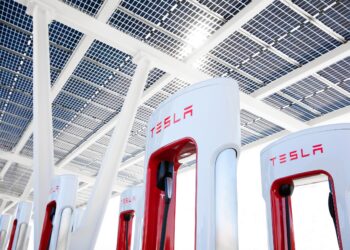New vehicles from the 2022 model year sold in the United States made good strides in the fuel economy and nasty emissions categories, which ultimately translates into cleaner air for us to breathe.
According to the Environmental Protection Agency’s (EPA’s) 2023 Automotive Trends Report, new vehicle carbon dioxide emissions and fuel economy had the biggest improvement of the last nine years, reaching record low CO2 emissions and record high fuel economy, on average.
That said, America’s (and the world’s) appetite for large SUVs and trucks has offset some of the benefits brought about by advancements in fuel-saving technologies and the increasing rates of electric vehicle adoption, with average new vehicle horsepower, weight, and footprint are also at record highs for the 2022 model year.
Get Fully Charged
More EVs on the road lead to lower CO2 emissions and higher fuel efficiency
With more and more electric vehicles being manufactured and sold in the United States, the average carbon dioxide (CO2) emissions for 2022 model year cars went down, while the average fuel economy went up. This means newer cars pollute less on average than their predecessors.
Tesla is seen as the benchmark when it comes to both fuel economy (miles per gallon equivalent in this case) and CO2 emissions, as the company’s entire portfolio of vehicles has zero tailpipe emissions.
Right after the American EV maker is Hyundai, which has its sights set on building more and more battery-powered vehicles in the following years and has seen good sales performance on the EV front so far. For the 2022 model year, Hyundai vehicles had an average estimated real-world fuel economy of 29.1 mpg, up from the 28.6 mpg reported in for the 2017 model year. On the CO2 emissions front, Hyundai went from 311 grams of CO2/mile to 302 g/mi.
Next up is Honda, but even though the Japanese manufacturer is third on the list, both the average estimated real-world fuel economy and the CO2 emissions were worse for the 2022 model year compared to the 2017 model year, with 28.7 mpg (down from 29.4 mpg) and 309 g of CO2/mile (up form 302 g/mi).
The biggest improvement, however, was recorded by Toyota. Its average real-world fuel consumption went from 25.3 mpg to 27.8 mpg, while the average CO2 emissions went from 352 g/mi to 319 g/mi. Looking at these numbers alone, it seems like the company’s strategy to put small batteries into a lot of cars instead of big batteries into fewer cars is paying dividends.
At the same time, Mazda had the biggest reversal, going from 29 mpg for the 2017 model year to 27 mpg on average for the 2022 model year vehicles, while the average CO2 emissions went up from 306 g/mi to 328 g/mi.
Stellantis, which owns several car marques including Dodge, Jeep, Chrysler, and Ram, is the worst-performing name out of the large car makers. That said, it did record slight improvements in both areas, with the average estimated real-world fuel economy going from 21.1 mpg for the 2017 model year to 21.3 mpg for the 2022MY, while the average CO2 emissions went down from 357 g/mi to 337 g/mi.
On average, when taking all the big manufacturers into consideration, there was an improvement on both fuel economy and CO2 emissions. Fuel economy went from 24.9 mpg for th 2017MY to 26 mpg for the 2022MY vehicles, while CO2 emissions went down from 357 g/mi to 337 g/mi.
With all this being said, the EPA makes it quite clear that smaller, lighter vehicles are a better choice when it comes to fuel economy and gas emissions. On average, 2022MY sedans and wagons had real-world CO2 emissions of 260 g/mi, while front-wheel-drive, sub-6,000-pound SUVs are surprisingly more environmentally friendly with an average of 250 g/mi for 2022MY vehicles.
Going into the truck segment, which includes four-wheel drive SUVs and/or vehicles that are over 6,000 lbs, things get visibly worse. SUVs in this category recorded average CO2 emissions of 364 g/mi, while minivans were at 339 g/mi and pickups scored 444 g/mi.
Predictions for the 2023 model year are optimistic, though, with the EPA saying that EVs, plug-in hybrids (PHEVs), and fuel cell electric vehicles (FCEVs) combined might see a 12% share in the model year 2023 production, up from the previous model year’s 7% and the 4% it represented in the 2021 model year.
In other words, as more and more hybrids and all-electric vehicles take to the streets, the average carbon dioxide emissions should slowly but surely decrease, making for a cleaner air. That said, what do we do with all the older cars that are still on the road? They can’t simply disappear overnight, and they’ll continue to emit nasty gases into the atmosphere until they get recycled or simply put off the road.
We’d like to know what you think about this, so head over to the comments section below to give us your thoughts.











